Life Vests for Infants, Toddlers and Preschoolers
Summer is here, friends! Hopefully you’ll take a well-deserved beach vacation, or at least hit the pool.
Life Jacket Basics
Whether you’re boating or just playing around at the pool, life jackets (also called PFDs – personal flotation devices) give parents an extra layer of protection against accidental drowning, which is the second leading cause of death in children under 14.
The Thing about Life Jackets
There are several campaigns out there warning parents about the dangers of Puddle Jumpers and other “floaty” style devices. The campaign is a little confusing, so allow me…
We used to go to our local YMCA, where they did not allow any type of life jackets in the pool. Why?? I couldn’t understand.
The gist is that if your child routinely wears a life jacket (of any type), they will be overly confident in the water because they are used to being supported by the device. The more often you use it, the more of a concern it is.
It’s actually very important for babies, toddlers and kids to be in the water (with a parent, of course!) without a life jacket — to feel themselves go underwater — to feel the water on their face — and to develop a healthy fear of the feeling of struggling in the water.

When they say Puddle Jumpers (and life jackets, in general) cause drownings, it’s misleading… they do not mean that children are drowning while wearing Puddle Jumpers. To the contrary: all of the life saving devices here are quite safe when worn properly (although there have been instances of drowning due to poor fit and children maneuvering their way out of the Puddle Jumpers). The problem is that children who are used to wearing life jackets are more likely to drown because they (and parents) develop a false sense of security.
Furthermore, Puddle Jumpers and other life jackets do NOT “teach kids how to swim.” These floaty devices, in particular, cause a child’s body to be oriented vertically in the water, instead of horizontally (the “swimming” position).

Bottom line: it’s best to use flotation devices only when needed (and trust me, they are often needed… but they aren’t always needed). For example, you are BBQ’ing by the pool and your kids are running around and you know you’ll be distracted by cooking. Or you’re swimming in a deep lake and you need that peace of mind.
Please read here for more on pool/water safety and implementing multiple layers of protection; and you can see this piece for more of the scoop on puddle jumpers specifically. Thank you!
Your garden-variety baby life jacket is a Type II PFD, which is for “near shore” rescue (as opposed to Type I, which is for rough, offshore conditions, and a longer rescue wait time). Type II jackets have head and neck support, which will typically upright an unconscious person — or a young child with poor body control — in the water. Thus, these are preferred for infants and young toddlers.
The big downside to Type II vests is that they are very bulky and restrictive – especially around the neck – and most kids initially resist when donning them for the first time. Not to worry though; with enough repetition, they’ll get used to it over time.
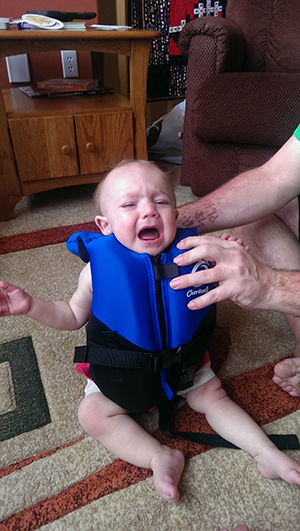
Completing the set, a Type III device is a “flotation aid” that can be used for preschoolers who have more body control and some swimming skills, with the caveat that they will not automatically turn a child upright in the water when immersed.
Most life jackets for children 30+ lbs are Type III devices. But when boating, especially in rough seas, I’d always opt for a Type II device no matter how good of a swimmer your child is.
You can read the U.S. Coast Guard’s full description for each PFD type/classification here.
** We can’t emphasize this enough: your little one should always be under close supervision, even with a life jacket. Even the best infant life jackets are only one layer of protection.
USCG-Approved Floatation for Boating and Swimming
Generally speaking, children under 13 are required to wear a life jacket while a vessel is underway, unless they are below deck or in an enclosed cabin. *Laws vary by state.
It’s generally not advised to take babies on boats, although many find this to be overly conservative (especially for families who LIVE on boats). Per the U.S. Coast Guard (USCG), “The PFDs currently available for newborns up to 18 pounds may not provide a proper fit to perform as expected. Unless the parent is able to test their newborns out in a PFD, sized for infants, in a swimming pool, they will not know if that device will float their child with his/her head out of the water. You must be sure you know the PFD you have works for your infant. Otherwise, we recommend the child not be exposed to any risk in a boat on the water.”
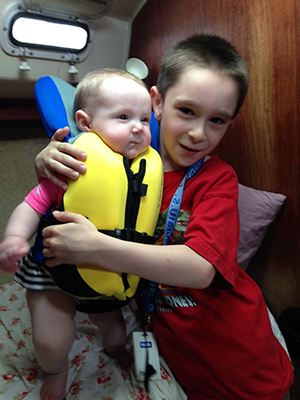
Bottom line: Test your baby’s life jacket beforehand in a pool or another controlled environment to make sure it works as intended.
Best Life Jackets for Infants, Toddlers, and Preschoolers
All of the following life jackets are USCG approved and may be used while boating. Always be sure to check the label on your child’s life vest to see which activities it’s approved for.
Make sure your child’s life jacket fits properly by having him/her make a “touchdown” signal by raising both arms straight up. If the life jacket hits a child’s chin or ears, it may be too big or the straps may be too loose.
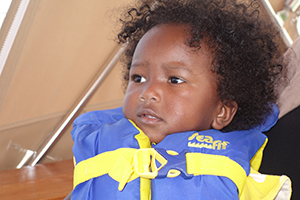
For Children Under 30 Lbs (which is up to 2 or 3 years old):
In truth, most infants and young toddlers are not thrilled about wearing a life vest. They are constricting and tend to crowd baby’s head and neck, especially a very young baby (3 months and under).
$ – Overton’s Infant Vest ~$24 – Editor’s Choice
USCG Type II PFD
These highly-rated Type II infant life jackets were specially designed for the needs of infants and young toddlers. The tapered front piece goes through the legs and connects to the back for a snug fit that won’t ride up. The oversized collar provides excellent head support in the water and the grab strap makes for easy recovery. *Like the others, this one is big for babies under 3 months.


$$ – Stearns Infant Classic Life Vest ~$29
USCG Type II PFD
This basic Type II vest also has all the necessary safety features, including a neck pad and a crotch strap to keep it from riding up. It’s also made of durable nylon and has a rescue handle for parents to easily lift their child from the water. Many agree that this vest is not the most comfortable, but overall, it’s a good quality infant/toddler vest and modestly priced to boot. We keep a couple of these on our boat in case we have younger guests aboard.
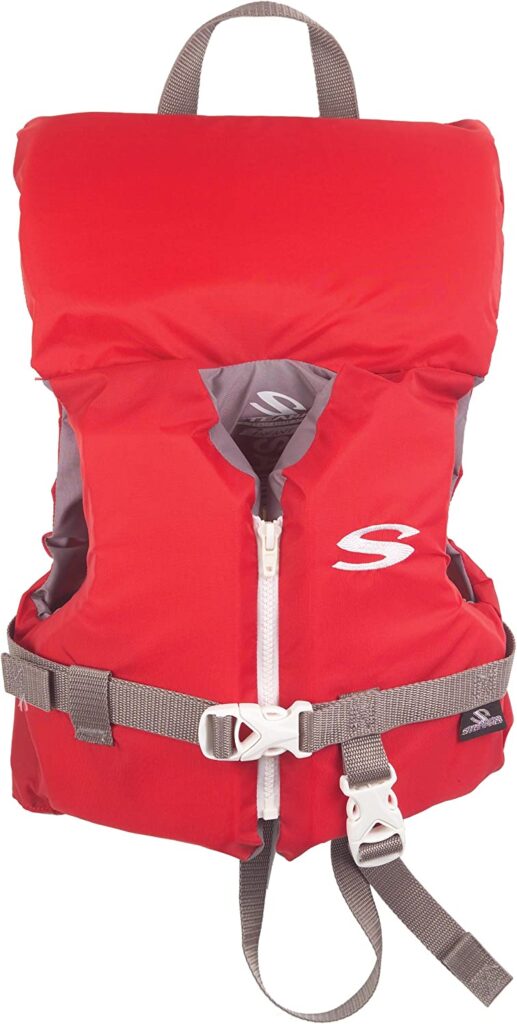

$$$ – Stohlquist Infant Personal Floatation Device ~$44
USCG Type II PFD
This highly rated infant floatation device by Stohlquist works for infants from 8 to 30 pounds. It comes with a crotch strap to ensure it stays in place, a convenient grab handle, a buckle across the front zipper for added security, and a wide neck opening for a more comfy fit. Like the others, this vest will keep babies on their backs in the water. It also features a double neck collar that fully supports infants’ heads. Parents really love this one for the younger crowd!


$$$ – O’Neill Kids Infant Superlite USCG Vest ~$35
USCG Type II PFD
This Type II life vest is US Coast Guard approved for babies up to 30 lbs. It contains closed cell PVC marine foam for a slimmer, lightweight design, and also helps babies float face-up. In addition, this vest offers protection against harsh ultraviolet rays.
O’Neill is a trusted name in the surfing industry, so you can expect this one to hold up longer than others. This would be my pick for frequent swimmers and boaters.


For children 30-50 Lbs:
$ – Stearns Kids Puddle Jumper Basic Life Jacket ~$27 – Editor’s Choice
USCG Type III/V PFD
The ever-popular Stearns Puddle Jumper is, in fact, Coast Guard approved as a flotation aid for pools, lakes, and beaches. It’s also technically approved for boating, but again, I would opt for a Type II jacket when boating. Puddle jumpers are best for 3- to 6-year-olds who can’t swim very well, although some readers noted that their 2-year-olds fit in it as well (Alice was 2.5 and LOVED it). For those taking multiple children to the pool and such, this is a must-have.
Safety Note:
Puddle Jumpers are NOT for infants or young toddlers who can’t keep themselves upright in the water — nor are they designed to turn an unconscious person face-up in the water.
Swim experts express concern that Puddle Jumpers don’t teach kids proper swimming form — instead, they keep kids in the vertical position. If your goal is to use a flotation device that teaches your child the proper swim position, keep reading…
Children get more freedom of movement with puddle jumpers compared to vests, though because there’s nothing constrictive around their head and neck. What I like best about the Puddle Jumper is that the clasp to remove it is in the back, so a child cannot remove it on his/her own, whereas I’ve seen many defiant young kids remove their own regular life vests when nobody was looking (which I personally find terrifying…)
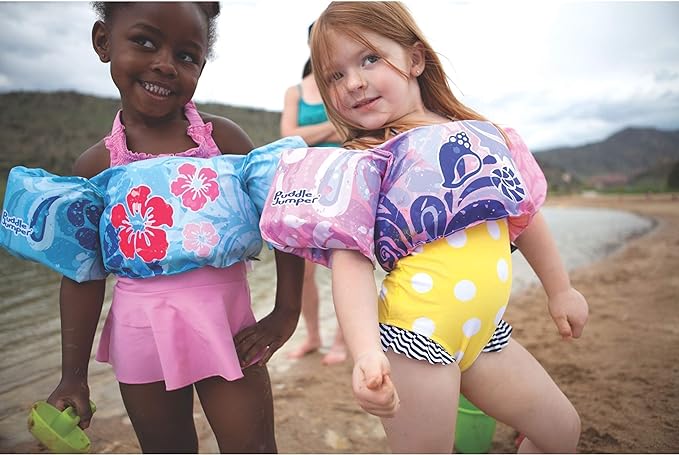

$ – Stearns Child’s Classic Series Vest ~$25
USCG Type III PFDs
Tied for second place, both the Stearns Child’s Classic Series Vest and Overton’s Children’s Nylon Vest are decently priced and Coast Guard approved Type III PFDs, which means they’re fine for boating, but don’t support the neck in the back like a Type II device. These are less constrictive for older kiddos who can right themselves in the water.
*The Stearns Child Classic Series Vest runs small!!
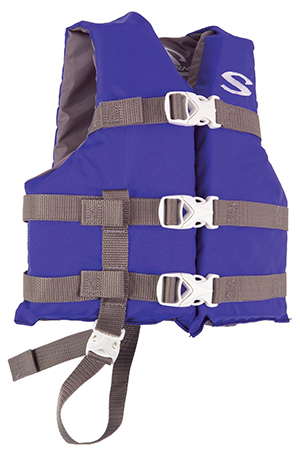

“That orange life vest you used to wear at camp” ~$14
USCG Type II PFD
Comfortable and stylish it is not, but this Type II jacket *should* upright a child who has fallen into the water, unlike its Type III counterparts. On the bright side, it’s cheap and easy to stack! This is the one to get when you need to buy in bulk.
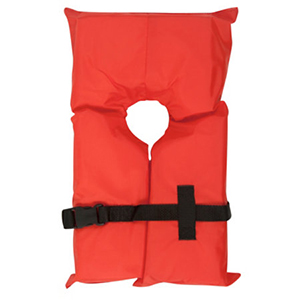

Finally, thanks to all those who weighed in on life jackets on Facebook!
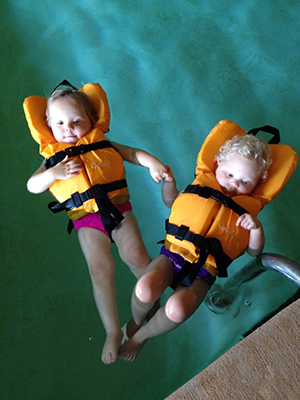
Happy Summer!
I HIGHLY recommend not buying a type II life jacket for infants online UNLESS you have visited a local West Marine or other boating store to try them on. Different jackets will fit different kids. Hubby and I did a ton of research online, decided on the best jacket, bought it on amazon and when we got it – it just didn’t fit our dd right. She looked more squished than the kid in the blue jacket pictured above. We had to return it. We went to west marine and tried a few on our daughter and found one that fit right.
Thank you for this article. May I also note: Please don’t buy life jackets at garage sales. Just like car seats, they get outdated and can wear out. The plastic buckles can get brittle, the foam inside could be waterlogged. Is $30-$50 really too much to spend on a life jacket for your child’s safety? I mean, come on, it’s called a “life” – jacket for a reason. 🙂
Thanks never thought about that
I agree with all of Lucie’s recommendations. The most important aspect of purchasing a lifejacket is checking to make sure it is US Coast Guard approved.
I manage many commercial swimming pools where the lifeguard checks to ensure the jacket is USCG approved. Unfortunately, many parents mistakenly purchase jackets that are not approved. If it is happening at pools, I’m sure it is happening on boats.
The CDC and most professional water safety associations only recommend USCG approved lifejackets.
As a former swimming instructor with many years of experience, I can say that life jackets are important for boating and open water. I see people using life jackets at the pool all the time, and they use them as babysitters. A life jacket can’t prevent a mean kid from dunking yours, water wings (which I NEVER recommend) can pop a hole, and all kinds of unpredictable things can happen. Sign your kids up for lessons so that they don’t have to rely on a PFD at the pool. Pay attention to what they learn in lessons and have them practice (without the PFD!). And please, please watch your kids. Drowning is scary and happens in an instant.
Might I add, I recommend the Speedo life jacket for infants up to 30 lbs? My son is 8.5 months and about 19-20 lbs, and the infant size speedo was a good fit for him. Its straps are nice and adjustable, including two crotch straps for a little less crotch-crushing. I like that it is neoprene, so it’s comfortable and not scratchy. It also has the rear head/neck piece and a grab strap, and is USCG approved. He didn’t mind it once he was used to the idea. We have now tried it in a river and a pool, and will be using it on a boat / at a lake later this summer.
Here’s the link, though I think the “girls” one is hideous.
https://www.amazon.com/Speedo-Infant-Life-Jacket-Electric/dp/B07H45R1VD/?tag=lucslis-20
Not sure if this will work, but here’s a link for a pic of my little guy in his life vest. https://www.facebook.com/photo.php?fbid=10100260201282027&l=563809e0af
I would strongly recommend taking a look at the Salus Marine Bijoux life jacket.
Salus is a Canadian company and all of their life jackets are certified by the Canadian Coast Guard. They are accepted by the USCG to satisfy the life preserver requirement for each person aboard.
The main difference is this – the minimum size the USCG will certify is 30lbs. The Salus Marine is certified by the CCG for 9-25lbs. We’ve used it for both our son and then our daughter.
Their jackets are comfortable and nicely proportioned for small kids. We bought the next size up for my son and will do it again when he needs it!
Different jackets will fit different kids. Hubby and I did a ton of research online, decided on the best jacket, bought it on amazon and when we got it – it just didn’t fit our dd right. She looked more squished than the kid in the blue jacket pictured above. We had to return it. We went to west marine and tried a few on our daughter and found one that fit right.
Thanks for that!
I also agree with some comment above that tell to buy infant life jacket in store near yor place, because you have to fit it with your child
Just a really great article! Tells parents exactly what they need to know and it’s hard to argue with your recommendations. I also appreciate the comment from the parent saying NOT to buy second hand. It’s not worth it!
For an infant, the Salus infant vest is by far the best. It is similar in style to the infant Overton vest, but it’s even less cumbersome.
This is excellent and informative article. I was a lifeguard, swim instructor and trainer for lifeguards, /instructors for many years. So many parents believe anything that floats will keep their child safe. I cannot count the times that lifeguards, where I have worked, have gone in after kids whose arm floaties have come off or innertube type floats have had issues. I’ve also worked with a number of kids who have been overly reliant on their flotation aid.
It would be great to see a refreashed version posted, so people don’t bypass it based on the date